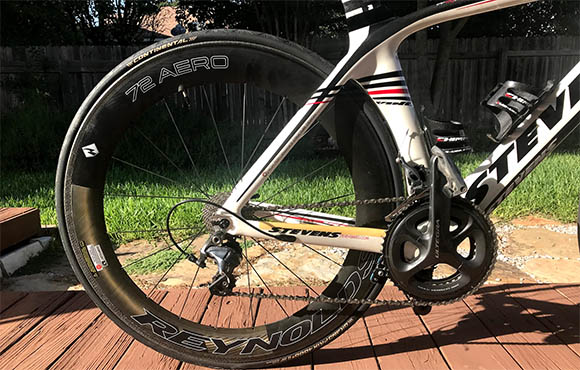
The Groupset
Have you ever gotten grease on your leg? This is from the messy part of the bike, where each pedal stroke is turned into power. The groupset is all the mechanical or electronic parts involved in changing gears, braking and running the drive train.
The drivetrain contains the crankset, cassette, chain front and rear derailleur. The crankset has a crank arm extending to the pedals and one to three chainrings with teeth. The inner chainring is often called the "granny gear" as it's easier to get up hills. A bike with two chainrings is said to have a double crank and one with three is called a triple crank. The cassette is a collection of sprockets attached to the rear wheel that are most commonly in groups of five to 12 sprockets. You can change the cassette on your bike for a flat road ride, which is an 11-23t (11 teeth on the smallest and 23 on the largest) to hilly rides at an 11-32t (32 teeth on the largest, like an extra granny gear). However, the clear majority of road bikes come with a 12-25t to cover both flat roads and hilly climbs.
The chain connects these two components, and the chains are dependent on the range of sprockets in the cassette. The front and rear derailleurs guide the chain from one sprocket and chainring to another. These connect to your shifters at the front of the bike, which allow you to switch between gears. On most bikes, your shifters will be very close to your brake levers and operated with a network of cables that can be hidden in the frame of the bike that connect to your brake calipers (the fancy term for the part that squeezes your wheel to make it stop). In recent years, disc brakes have become more popular, where the braking force is closer to the inside of the wheel like a car.
The groupset requires the most maintenance on any bike, given you are not getting a flat every time you ride. Chain wears and stretches over time and builds up gunk, so it important to clean and lube it every 500 miles. As a cyclist, it is important to avoid cross chaining. This is when the chain is set on the large (outside) chainring on the front crankset and the large (inside) sprocket in the back. This will cause a heinous noise but can also stretch your chain, rub the chainstays and weakens the teeth. Every 2,500 miles you should get a tune-up, so a professional can look at the cables and cable housing—the flexible outer-tubing that surrounds the cable. Lastly, you should periodically check how your brakes are wearing. Cleaning your brakes every 500 miles is also a good idea. Use isopropyl alcohol to wipe them down and a nail file to clean out the grooves of the brake pads.
Just like every cyclist deserves some TLC, so does your bike. Owning one of these machines can bring you new adventures if you perform appropriate maintenance and know when to bring it to a mechanic. It is best to store your bike inside, away from moisture, rain and dirt that might wear your bike down. If you ever crash your bike or buy used, have a mechanic look it over from wheel to wheel before riding. Remember, knowing the lingo doesn't make a good rider, but it sure can help!
 READ THIS NEXT: 5 Simple Tips to Master DIY Bike Repair
READ THIS NEXT: 5 Simple Tips to Master DIY Bike Repair


